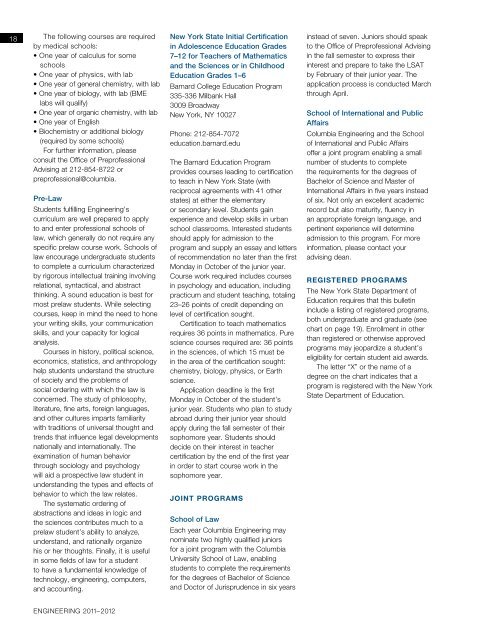2011-2012 Bulletin â PDF - SEAS Bulletin - Columbia University
2011-2012 Bulletin â PDF - SEAS Bulletin - Columbia University
2011-2012 Bulletin â PDF - SEAS Bulletin - Columbia University
Create successful ePaper yourself
Turn your PDF publications into a flip-book with our unique Google optimized e-Paper software.
18 The following courses are required<br />
by medical schools:<br />
• One year of calculus for some<br />
schools<br />
• One year of physics, with lab<br />
• One year of general chemistry, with lab<br />
• One year of biology, with lab (BME<br />
labs will qualify)<br />
• One year of organic chemistry, with lab<br />
• One year of English<br />
• Biochemistry or additional biology<br />
(required by some schools)<br />
For further information, please<br />
consult the Office of Preprofessional<br />
Advising at 212-854-8722 or<br />
preprofessional@columbia.<br />
Pre-Law<br />
Students fulfilling Engineering’s<br />
curriculum are well prepared to apply<br />
to and enter professional schools of<br />
law, which generally do not require any<br />
specific prelaw course work. Schools of<br />
law encourage undergraduate students<br />
to complete a curriculum characterized<br />
by rigorous intellectual training involving<br />
relational, syntactical, and abstract<br />
thinking. A sound education is best for<br />
most prelaw students. While selecting<br />
courses, keep in mind the need to hone<br />
your writing skills, your communication<br />
skills, and your capacity for logical<br />
analysis.<br />
Courses in history, political science,<br />
economics, statistics, and anthropology<br />
help students understand the structure<br />
of society and the problems of<br />
social ordering with which the law is<br />
concerned. The study of philosophy,<br />
literature, fine arts, foreign languages,<br />
and other cultures imparts familiarity<br />
with traditions of universal thought and<br />
trends that influence legal developments<br />
nationally and internationally. The<br />
examination of human behavior<br />
through sociology and psychology<br />
will aid a prospective law student in<br />
understanding the types and effects of<br />
behavior to which the law relates.<br />
The systematic ordering of<br />
abstractions and ideas in logic and<br />
the sciences contributes much to a<br />
prelaw student’s ability to analyze,<br />
understand, and rationally organize<br />
his or her thoughts. Finally, it is useful<br />
in some fields of law for a student<br />
to have a fundamental knowledge of<br />
technology, engineering, computers,<br />
and accounting.<br />
New York State Initial Certification<br />
in Adolescence Education Grades<br />
7–12 for Teachers of Mathematics<br />
and the Sciences or in Childhood<br />
Education Grades 1–6<br />
Barnard College Education Program<br />
335-336 Milbank Hall<br />
3009 Broadway<br />
New York, NY 10027<br />
Phone: 212-854-7072<br />
education.barnard.edu<br />
The Barnard Education Program<br />
provides courses leading to certification<br />
to teach in New York State (with<br />
reciprocal agreements with 41 other<br />
states) at either the elementary<br />
or secondary level. Students gain<br />
experience and develop skills in urban<br />
school classrooms. Interested students<br />
should apply for admission to the<br />
program and supply an essay and letters<br />
of recommendation no later than the first<br />
Monday in October of the junior year.<br />
Course work required includes courses<br />
in psychology and education, including<br />
practicum and student teaching, totaling<br />
23–26 points of credit depending on<br />
level of certification sought.<br />
Certification to teach mathematics<br />
requires 36 points in mathematics. Pure<br />
science courses required are: 36 points<br />
in the sciences, of which 15 must be<br />
in the area of the certification sought:<br />
chemistry, biology, physics, or Earth<br />
science.<br />
Application deadline is the first<br />
Monday in October of the student’s<br />
junior year. Students who plan to study<br />
abroad during their junior year should<br />
apply during the fall semester of their<br />
sophomore year. Students should<br />
decide on their interest in teacher<br />
certification by the end of the first year<br />
in order to start course work in the<br />
sophomore year.<br />
Joint Programs<br />
School of Law<br />
Each year <strong>Columbia</strong> Engineering may<br />
nominate two highly qualified juniors<br />
for a joint program with the <strong>Columbia</strong><br />
<strong>University</strong> School of Law, enabling<br />
students to complete the requirements<br />
for the degrees of Bachelor of Science<br />
and Doctor of Jurisprudence in six years<br />
instead of seven. Juniors should speak<br />
to the Office of Preprofessional Advising<br />
in the fall semester to express their<br />
interest and prepare to take the LSAT<br />
by February of their junior year. The<br />
application process is conducted March<br />
through April.<br />
School of International and Public<br />
Affairs<br />
<strong>Columbia</strong> Engineering and the School<br />
of International and Public Affairs<br />
offer a joint program enabling a small<br />
number of students to complete<br />
the requirements for the degrees of<br />
Bachelor of Science and Master of<br />
International Affairs in five years instead<br />
of six. Not only an excellent academic<br />
record but also maturity, fluency in<br />
an appropriate foreign language, and<br />
pertinent experience will determine<br />
admission to this program. For more<br />
information, please contact your<br />
advising dean.<br />
Registered Programs<br />
The New York State Department of<br />
Education requires that this bulletin<br />
include a listing of registered programs,<br />
both undergraduate and graduate (see<br />
chart on page 19). Enrollment in other<br />
than registered or otherwise approved<br />
programs may jeopardize a student’s<br />
eligibility for certain student aid awards.<br />
The letter “X” or the name of a<br />
degree on the chart indicates that a<br />
program is registered with the New York<br />
State Department of Education.<br />
engineering <strong>2011</strong>–<strong>2012</strong>







